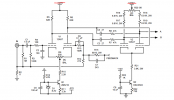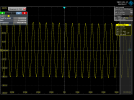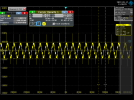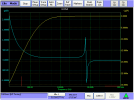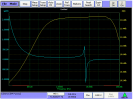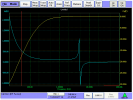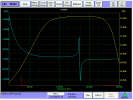I can’t tell if it’s true because its meaning is mysterious. But toroids can have better bandwidth than, say, EI, and lower distortion in a circuit. The only caveat is the criticality of balance of idle current.I don't know exactly, probably that are more prone to some external interference, as I understood. But I am not sure if it is true, just quoted opinion.
-
Welcome to ASR. There are many reviews of audio hardware and expert members to help answer your questions. Click here to have your audio equipment measured for free!
You are using an out of date browser. It may not display this or other websites correctly.
You should upgrade or use an alternative browser.
You should upgrade or use an alternative browser.
Building a valve amplifier
- Thread starter horias2000
- Start date
OP
- Thread Starter
- #22
I agree, most probably the output transformer saturated. I will reset all the currents and I will start with openloop. The only part where I can compensate is C6+R22 and C5+R21. In the article, Bob Cordell is mentioning that with an of the shelf transformer (4300OHM primary) the only change necessary is C5/C6 to 22pF and R21/R22 to 100k. So I will look at these components and I will try to see the effects of changing one value.With that current imbalance, you’ve likely saturating the output transformer which isn’t helping.
First thing I’d do for stability is to work on the compensation to shape the open loop gain. If that doesn’t get you there, it’s time to adjust the feedback network lead compensation.
On the net somewhere, there’s a terrific and relevant article by Norman Crowhurst from the 1950s with a title something like Amplifier Adjustments When Fitting A New Output Transformer.
Another issue is that the feedback resistor has a capacitor over it, for lead compensation (C13). In the original article the value of the capacitor is not 100% clear as it only says "243". To me, this can be 24nF (not a standard value) so I used 22nF but looking at other designs, this is significantly higher (~47uF). So one thing I will try, is to increase this to 47uF and see if this has any affect on AC stability. But this after I make sure it is stable in openloop. The same thing (unclear value) is valid for R12. It says "274" in the article and I used 270OHM, although this seems to be a bit low but other schematics I've see have similarly low values.
OP
- Thread Starter
- #23
Well I'm surprised to hear this as most of the articles I've read say that a good toroidal output transformer can reduce distortion and can have very flat frequency response. The only downside being that it is more prone to saturation if you have DC on it than the classic EI cores. I'm pretty new to the valve amplifier field so I can't say anything from experience yet. I will definitely measure the amp once I have it stable and working.I only know the opinions from the person who built tube amps, he said that toroidal transformers should be avoided since they spread distortion.
He also was making his own transformers very carefully, with some special cores and winding technics. But as I said, that is and opinion. I believe that many factors matter in tube amps. In power supply capacitors are probably even more important, their total capacity, ESR, by-pass caps etc.
So if you want to build good tube amp for listening make no compromises in the power supply. Good quality oversided transformer is important. As far as polish toroids they are probably good in price/performance ratio but the best sounding tube amps I heard did not used toroids, as far as KT-88 concerned the best I heard is Air Tight ATM-2. This is SOTA amplifier, however not the power beast like some Audio Research or Jadis...
Here it is. Page 19.
OP
- Thread Starter
- #25
I've read through the article. It ends in an abrupt way and it does not continue on page 22Here it is. Page 19.
Happy to help. Wish I were closer, but that's also me selfishly wanting better access to Feteasca Neagra.I've read through the article. It ends in an abrupt way and it does not continue on page 22. But nevertheless, it confirmed to me the points where I should work on. First it is the lead capacitor onto the feedback resistor. For sure this needs to be of a higher value. I will try with 47u. And then the RC networks onto the driver stage will most probably have an effect. I will also add R-C networks over the primary windings of the output transformer as these will most probably have an effect on the square wave behavior. Again, thanks a lot for your assistance. It is highly appreciated.
OP
- Thread Starter
- #28
I did some more tweaking and I managed to get rid of the oscillation. I started with openloop and it was stable but a small 50Hz oscillation. I'm assuming this has to do with ground loops. When connecting the feedback loop, it stated oscillating like crazy. It had a low frequency oscillation of 3-400Hz and a 16Vp-p and a higher frequency one (1-1.2Mhz) over. Once I added the RC zobel network on the output, the low frequency oscillation went away but I still had the high frequency one at around 300kHz and around 5Vp-p. I added an RC (200pF+1k) over each half of the primaries and the frequency of the oscillation went to around 400kHz and the amplitude dropped to below 3Vp-p. I then changed R21/R22 (from the images in my previous post) and the oscillation went away. There is still a low 50Hz oscillation but this might be a ground loop. I then applied a 1kHz signal (200mVp-p) on the input and the output looked very nice. The strange thing is that when I used a 10kHz input, the output amplitude went way down (0.2Vrms from 1,3Vrms). So there is definitely a capacitor (or more) that have a wrong value and that affects the HF response. I had a quick look but everything seemed fine. There is the lead capacitor that has a strange value in the original schematic (274) and that I assumed it was a 27nF and I used a 22nF. I tried adding a 1uF in parallel with this but nothing. The stability of the amp is still not 100% as it still oscillates in some cases. I'm now expecting a delivery from Mouser with some more components. I will increase the value of the capacitor from the RC networks placed on the primaries. I will try with 1nF and I will increase/decrease the resistor. At the moment the high HF attenuation is the one concerning me. As this might also be the culprit for the oscillations. Ah, I almost forgot, I also tested with square wave on the input (1kHz) and the output was almost a triangle. So there is definitely some HF roll-off somewhere.
Remk
Member
Stop trying with the feedback, first get it stable without(And do test this to into Mhz regions as you already noticed it instable there)I did some more tweaking and I managed to get rid of the oscillation. I started with openloop and it was stable but a small 50Hz oscillation. I'm assuming this has to do with ground loops. When connecting the feedback loop, it stated oscillating like crazy. It had a low frequency oscillation of 3-400Hz and a 16Vp-p and a higher frequency one (1-1.2Mhz) over. Once I added the RC zobel network on the output, the low frequency oscillation went away but I still had the high frequency one at around 300kHz and around 5Vp-p. I added an RC (200pF+1k) over each half of the primaries and the frequency of the oscillation went to around 400kHz and the amplitude dropped to below 3Vp-p. I then changed R21/R22 (from the images in my previous post) and the oscillation went away. There is still a low 50Hz oscillation but this might be a ground loop. I then applied a 1kHz signal (200mVp-p) on the input and the output looked very nice. The strange thing is that when I used a 10kHz input, the output amplitude went way down (0.2Vrms from 1,3Vrms). So there is definitely a capacitor (or more) that have a wrong value and that affects the HF response. I had a quick look but everything seemed fine. There is the lead capacitor that has a strange value in the original schematic (274) and that I assumed it was a 27nF and I used a 22nF. I tried adding a 1uF in parallel with this but nothing. The stability of the amp is still not 100% as it still oscillates in some cases. I'm now expecting a delivery from Mouser with some more components. I will increase the value of the capacitor from the RC networks placed on the primaries. I will try with 1nF and I will increase/decrease the resistor. At the moment the high HF attenuation is the one concerning me. As this might also be the culprit for the oscillations. Ah, I almost forgot, I also tested with square wave on the input (1kHz) and the output was almost a triangle. So there is definitely some HF roll-off somewhere.
If the base amplifier without feedback get to oscilate there is something wrong somewhere else.
You can't make a instable design stable by adding fb, fb connected wrong wil get you a oscillating amp(wil give you positive feedback).
1kHz signal (200mVp-p) on the input and the output looked very nice. The strange thing is that when I used a 10kHz input, the output amplitude went way down (0.2Vrms from 1,3Vrms)
That is not a wrong cap value! possible caused by the oscilation. The lowest freqency passed to the next stage depands by this value, not the higher frequency's.
The 50Hz oscilation; you checked this with scope, arta?
Can't it be that those are just hum from heater or powersupply?
Rem.
OP
- Thread Starter
- #30
Ok, I will keep testing without feedback. Coming from solid state amplifiers, I'm really not comfortable working without feedback. A solid state amp will instantly saturate to one rail and the magic smoke would come out of the final transistors or will start oscillating like crazy.Stop trying with the feedback, first get it stable without(And do test this to into Mhz regions as you already noticed it instable there)
If the base amplifier without feedback get to oscilate there is something wrong somewhere else.
You can't make a instable design stable by adding fb, fb connected wrong wil get you a oscillating amp(wil give you positive feedback).
1kHz signal (200mVp-p) on the input and the output looked very nice. The strange thing is that when I used a 10kHz input, the output amplitude went way down (0.2Vrms from 1,3Vrms)
That is not a wrong cap value! possible caused by the oscilation. The lowest freqency passed to the next stage depands by this value, not the higher frequency's.
The 50Hz oscilation; you checked this with scope, arta?
Can't it be that those are just hum from heater or powersupply?
Rem.
I'm not sure I got what you meant on your second comment regarding the cap value. Having a 16dB attenuation at 10kHz compared with 1kHz tells me there is a low pass filter acting up way too early
I'm measuring the output on a 8OHM load with a scope. The 50Hz might come from the filament voltage, indeed. I will have a look at this.
Thanks for the input.
What you want is the open loop gain rolling off early. You might consider reworking how they do the compensation before trying to close the loop. If it were me, I'd have a series RC network between the plates of one of the differential pairs (probably the first one since there seems to be two) and get rid of the rest. The other thing that doesn't bother me is having the overall closed loop response rolling off a bit on the top- if the amp is -2dB (say) at 20kHz, well, "shrug."Ok, I will keep testing without feedback. Coming from solid state amplifiers, I'm really not comfortable working without feedback. A solid state amp will instantly saturate to one rail and the magic smoke would come out of the final transistors or will start oscillating like crazy.
I'm not sure I got what you meant on your second comment regarding the cap value. Having a 16dB attenuation at 10kHz compared with 1kHz tells me there is a low pass filter acting up way too early
I'm measuring the output on a 8OHM load with a scope. The 50Hz might come from the filament voltage, indeed. I will have a look at this.
Thanks for the input.
Yes, the 50 is likely hum pickup. If there were oscillation there (motorboating), this would be a power supply decoupling issue.
OP
- Thread Starter
- #32
I measured the open loop frequency response with the modification I made so far (22pF+33k between the plates of V1 and V2 and 200p+1k across each primary). I have around 50dB at 1kHz (100mVp-p input and 32.2Vp-p output ). This is from the 8OHM tap and with 8OHM resistor loading this output. Apart from the 50Hz noise or oscillation, everything seems stable. As you can see, there is no steep roll-off from 1kHz to 10kHz when running openloop. This means that the HF roll-off is due to the feedback loop compensation. I also ran a square wave input and it looks a lot better than with the loop closed. There is still some ringing so I will look at the RC network between the two stages (V1 and V2) and see how I can improve this. @SIY do you mean that I should add an RC network between the plates of V1 (see attached image with the schematic). I do have RC networks between the plates of V1 and V2 (22pF+33K). I also attached a scope capture with the 50Hz noise/oscillation. It's pretty hefty at 4Vp-p over 8OHM load.


| Frequency [Hz] | RMS [V] | Peak - peak [V] | Input [V] | Open loop gain [dB] |
10 | 3.24 | 11.76 | 0.1 | 41.41 |
20 | 4.37 | 16.11 | 0.1 | 44.14 |
30 | 5.48 | 19.07 | 0.1 | 45.61 |
40 | 6.48 | 20 | 0.1 | 46.02 |
50 | 7.01 | 20.65 | 0.1 | 46.30 |
60 | 8.01 | 25.3 | 0.1 | 48.06 |
80 | 9.1 | 28.06 | 0.1 | 48.96 |
100 | 9.78 | 28.64 | 0.1 | 49.14 |
200 | 10.98 | 32.35 | 0.1 | 50.20 |
300 | 11.3 | 32.83 | 0.1 | 50.33 |
400 | 11.45 | 33.16 | 0.1 | 50.41 |
500 | 11.46 | 33.34 | 0.1 | 50.46 |
1000 | 11.16 | 32.19 | 0.1 | 50.15 |
10000 | 9.32 | 27.18 | 0.1 | 48.68 |
20000 | 8.57 | 24.61 | 0.1 | 47.82 |
30000 | 10.59 | 30.07 | 0.1 | 49.56 |
40000 | 12.46 | 35.35 | 0.1 | 50.97 |
50000 | 7.06 | 20.33 | 0.1 | 46.16 |
60000 | 3.43 | 10.02 | 0.1 | 40.02 |
70000 | 2.1 | 6.18 | 0.1 | 35.82 |
80000 | 1.44 | 4.19 | 0.1 | 32.44 |
90000 | 1.12 | 3.12 | 0.1 | 29.88 |
100000 | 0.82 | 2.42 | 0.1 | 27.68 |
Attachments
Your open loop gain needs to be rolling off well before it is. There's a lot not to like in that circuit...
In any case, get rid of all the stuff around the transformer and the RC feedback from V2 to V1. Slug the dominant pole with an RC series between the two plates of V1; this will have to be experimented with, but I'd start with maybe 10k and 1500pF. What you want to see is a 6dB/octave rolloff starting at, say, 4-5kHz open loop. Once you get that, you can start trying to apply the feedback.
You also will need to see where the hum is coming from- the grounding is the first place I'd look.
In any case, get rid of all the stuff around the transformer and the RC feedback from V2 to V1. Slug the dominant pole with an RC series between the two plates of V1; this will have to be experimented with, but I'd start with maybe 10k and 1500pF. What you want to see is a 6dB/octave rolloff starting at, say, 4-5kHz open loop. Once you get that, you can start trying to apply the feedback.
You also will need to see where the hum is coming from- the grounding is the first place I'd look.
OP
- Thread Starter
- #35
I removed all the compensations I used before (R-C from V1 to V2 and R-C over the primaries) and I added a 15nF+1k from plate to plate of V1. The result is shown below:Your open loop gain needs to be rolling off well before it is. There's a lot not to like in that circuit...
In any case, get rid of all the stuff around the transformer and the RC feedback from V2 to V1. Slug the dominant pole with an RC series between the two plates of V1; this will have to be experimented with, but I'd start with maybe 10k and 1500pF. What you want to see is a 6dB/octave rolloff starting at, say, 4-5kHz open loop. Once you get that, you can start trying to apply the feedback.
You also will need to see where the hum is coming from- the grounding is the first place I'd look.
I can see a "boost" of low frequencies and after 2-300Hz it starts dropping. The 50Hz is still there but it is a bit smaller (1.5Vp-p). The 1kHz square wave response is shown below. It still looks like a triangle.
That's good, though the rolloff is a bit low. We can fix that later. That's exactly what you want the square wave to look like open loop. If you change the x axis to a log plot, it should look like a proper Bode plot.
Now you can start applying loop feedback. If applying a little bit screws up the stability, then you're actually applying positive feedback which you can fix by reversing the polarity of the output transformer.
Now you can start applying loop feedback. If applying a little bit screws up the stability, then you're actually applying positive feedback which you can fix by reversing the polarity of the output transformer.
F
freemansteve
Guest
I was of the impression that toroidals radiated less noise, but I've never seen measurements.
And maybe the internals vibrate less than standard transformers.
Not massively important either way since switching PSUs have become so good.
Or is this only about valve amp output transformers?
And maybe the internals vibrate less than standard transformers.
Not massively important either way since switching PSUs have become so good.
Or is this only about valve amp output transformers?
OP
- Thread Starter
- #38
Ok, I will try on Monday to connect the feedback loop as it is and see if it's stable. I will also try to reverse the output winding polarity if it oscillates.That's good, though the rolloff is a bit low. We can fix that later. That's exactly what you want the square wave to look like open loop. If you change the x axis to a log plot, it should look like a proper Bode plot.
Now you can start applying loop feedback. If applying a little bit screws up the stability, then you're actually applying positive feedback which you can fix by reversing the polarity of the output transformer.
I think that the 50Hz might be an oscillation actually and not noise pickup. I used 1.5uF instead of the 1.5nF by mistake
Thanks again for your help. Highly appreciated.
Last edited:
OP
- Thread Starter
- #39
Yep, the thread is about building the C70 valve amplifier designed by Bob Cordell. It is my first tube amplifier and I was not sure which way to go, toroids or classical EI cores. I went for toroids in the endI was of the impression that toroidals radiated less noise, but I've never seen measurements.
And maybe the internals vibrate less than standard transformers.
Not massively important either way since switching PSUs have become so good.
Or is this only about valve amp output transformers?
OP
- Thread Starter
- #40
I did not have the time to close the feedback loop yet. I hope to do this later today. i did have the time to measure the output transformer using an impedance analyzer. I looked at L, C and Z for a frequency range of 20Hz - 100kHz. I used a 10k resistor in series with the primary in order to simulate a pentode. I measured each primary half separately while loading the 8OHM output with 8OHM. Attached you can see results for both primary winding halves. Maybe this information will help others using the same output transformers ( Toroidy - TTG-EL34PP ).
)
)
Attachments
Last edited:
Similar threads
- Replies
- 5
- Views
- 805
- Replies
- 1
- Views
- 349
- Poll
- Replies
- 346
- Views
- 57K
- Replies
- 41
- Views
- 7K
